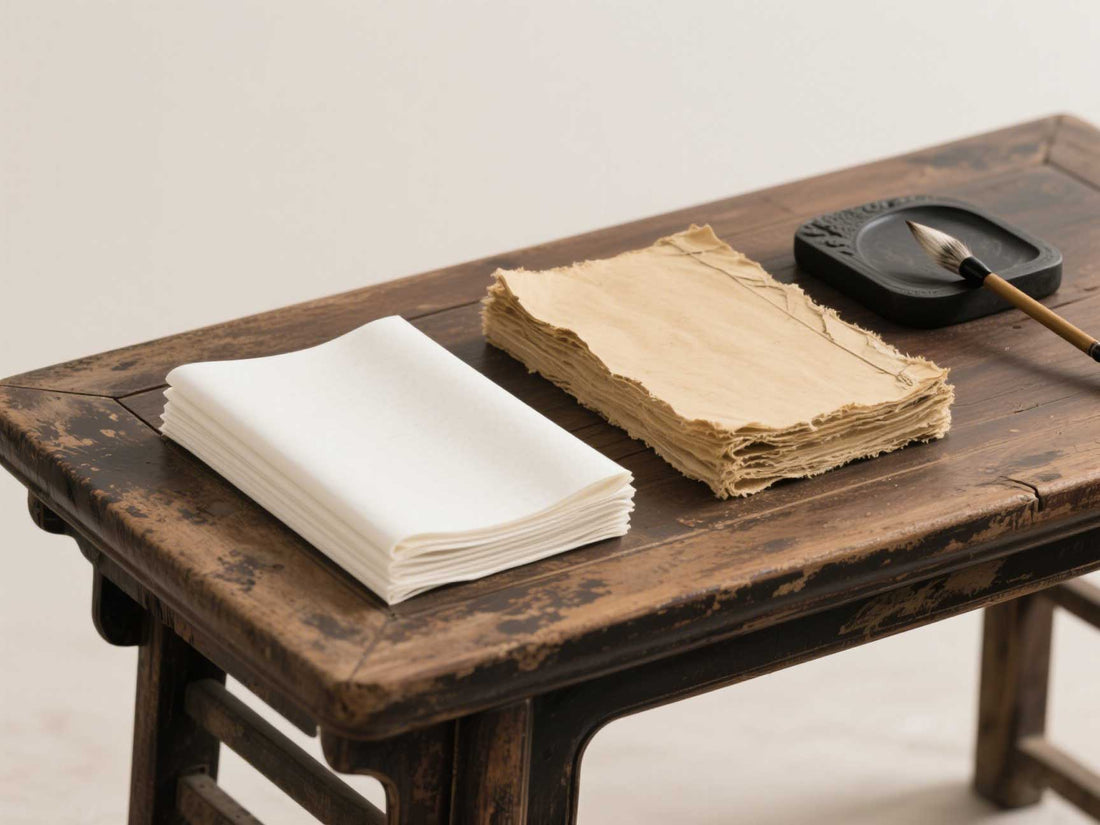
The difference between rough paper and rice paper
Share
The following is a comparison of the core differences between the two in terms of raw materials, processes, characteristics, uses, etc.:
1. Raw materials and origin
Rough paper: Made from bamboo fiber (mostly young bamboo), some machine-made paper may be mixed with straw or other fibers.
The production area is wide, and Jiajiang, Sichuan is one of the famous rough-edged paper production areas.
Xuan paper: The core raw materials are the bark of the zelkova tree and rice straw, and it must be produced in Jingxian County, Anhui Province to be called Xuan paper.
2. Production process
| category | Process characteristics | Paper type |
| Rough edge paper |
The manual method requires soaking bamboo, fermenting with lime, and scooping out the paper to dry; Machine-made paper is mechanically pressed, and the process is simplified |
Handmade rough-edged paper and machine-made rough-edged paper |
| Rice paper | It needs to go through 108 processes, including soaking, mashing, bleaching, etc., and the whole process is handmade | Divided into raw xuan xuan, cooked xuan xuan and semi-raw cooked xuan xuan |
3. Comparison of physical properties
-
Ink absorption
- Rough-edged paper: It absorbs ink at a medium speed and has a uniform ink color, which is suitable for beginners to master ;
- Xuan paper: Raw xuan paper absorbs ink very quickly (easy to blur ink), cooked xuan paper absorbs ink weakly, and semi-raw xuan paper is in the middle.
-
Texture and feel
- Rough-edged paper: Handmade paper has the same feel on both sides, while machine-made paper has a smooth one side and a rough one side ;
- Xuan paper: Raw Xuan paper is thin and flexible, while cooked Xuan paper has a smooth surface like wax .
-
Durability
- Rough-edged paper: If not stored properly, it will become brittle and yellow, and its lifespan is short;
- Xuan paper: Because it contains sandalwood fiber, it can be preserved for a thousand years without rotting (hence it is called "thousand-year longevity paper").
4. Differences in usage
-
Rough edge paper :
- Suitable for daily calligraphy practice (regular script, official script, etc.), cost-effective;
- Machine-made paper is mostly used for beginners, while handmade paper is suitable for creations that pursue a simple and rustic texture.
-
Rice paper :
- Xuan paper : ink painting, cursive calligraphy (rich ink color);
- Rice paper : fine brushwork, small regular script writing (no ink bleeding);
- Semi-raw Xuan paper : for practicing and creating running script and seal script (balanced ink absorption).
5. Price and cost performance
- Rough paper : low price, suitable for large-scale consumption;
- Xuan paper : more expensive, mostly used for formal works
6. Identification skills
| method | Rough edge paper | Rice paper |
| Light transmission observation | The texture of bamboo fiber is uneven and may contain impurities | The fibers are fine and uniform, and the light is translucent like clouds (characteristic of sandalwood bark) |
| Water drop test | Water stains spread at a medium speed | Raw rice paper spreads quickly, but cooked rice paper does not spread |
| Rub test | Prone to cracks (especially machine-made paper) | The fiber is strong and can be restored to flatness after rubbing |
Summary and recommendations
- Beginners : Use machine-made rough-edged paper to practice pen control and ink volume control;
- Advanced creation : switch the type of rice paper according to the style of calligraphy (e.g. use semi-cooked rice paper for running script and cooked rice paper for regular script);
- Collectible works : Authentic Anhui Xuan paper must be selected to ensure durability and artistic value.
